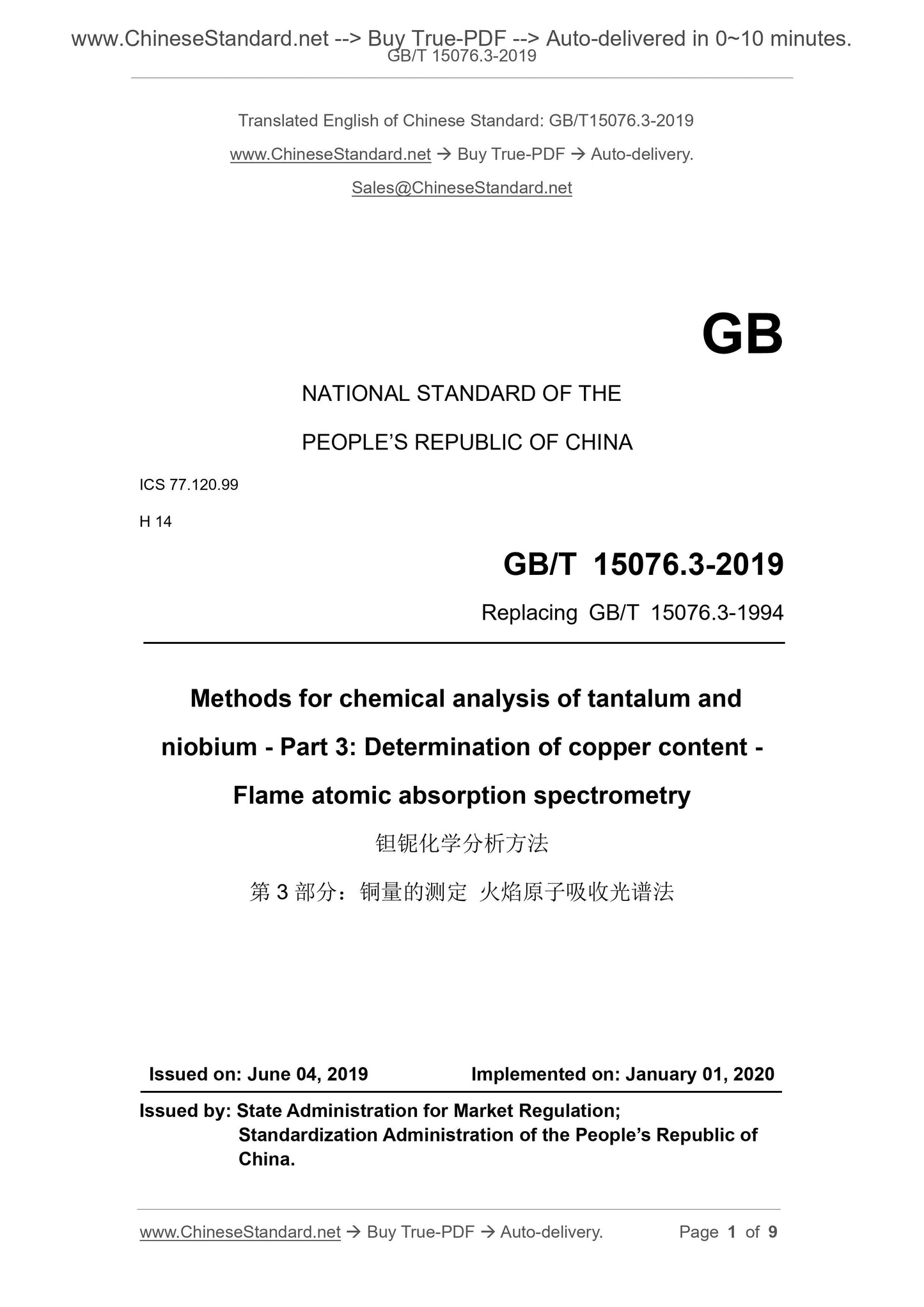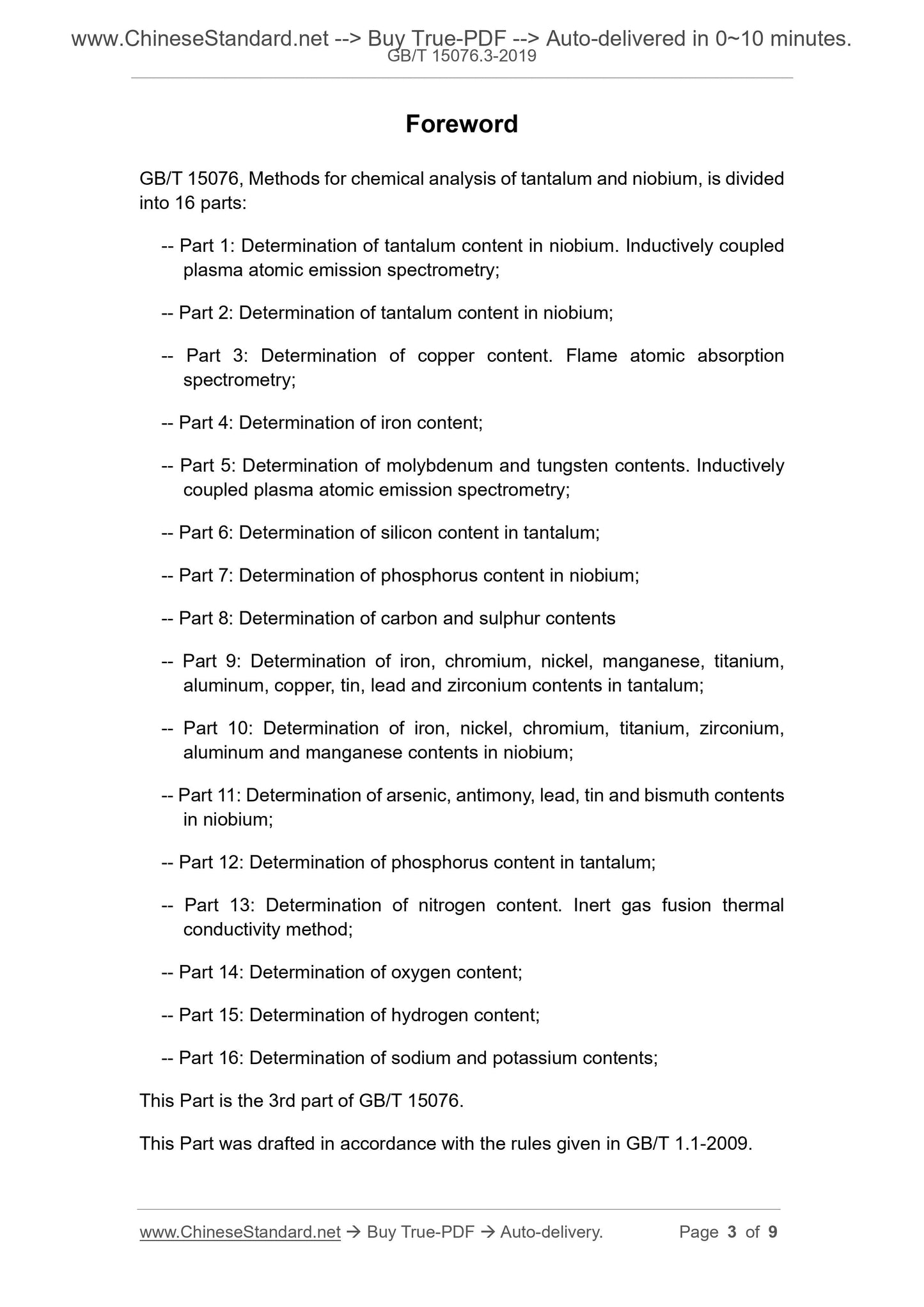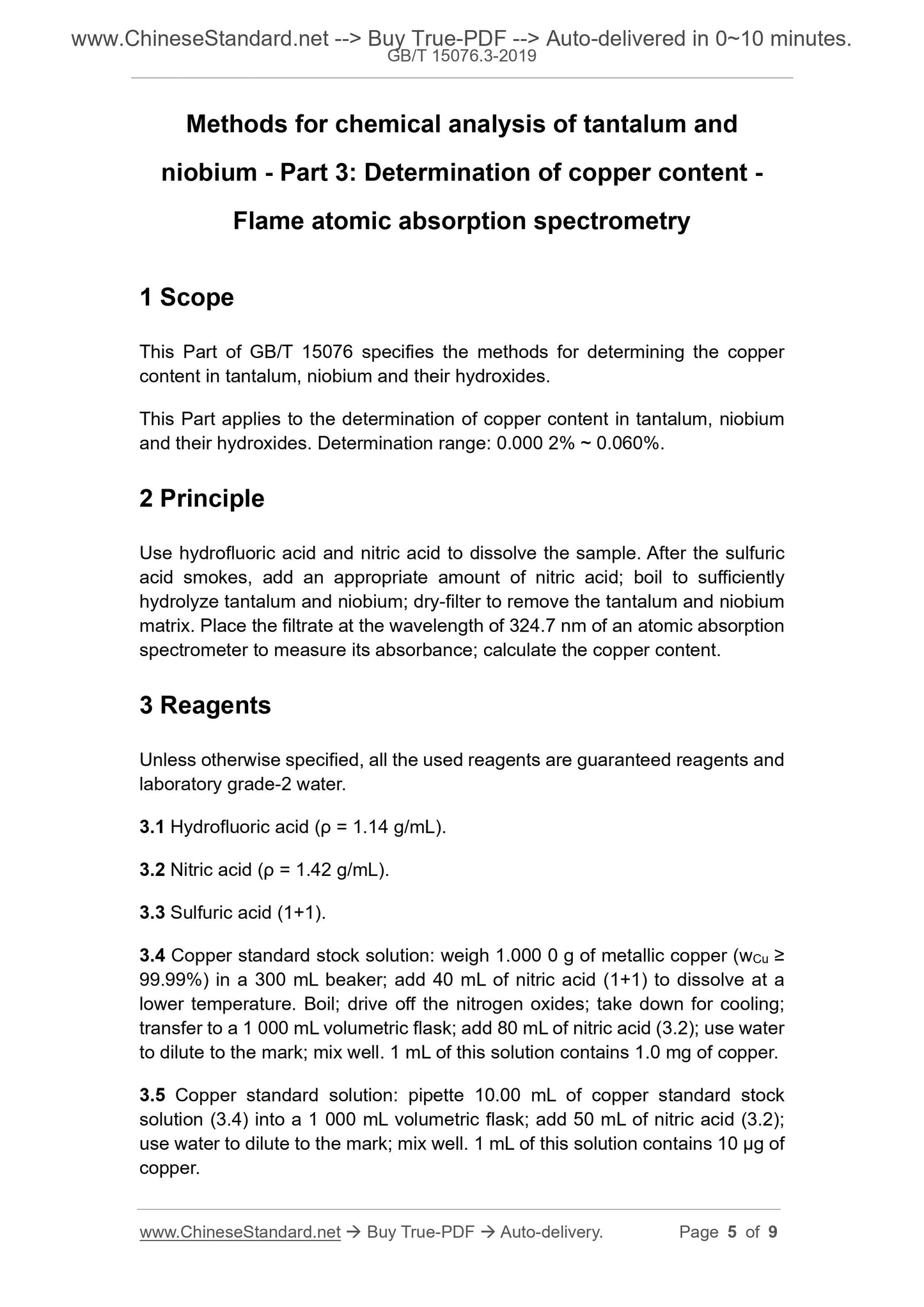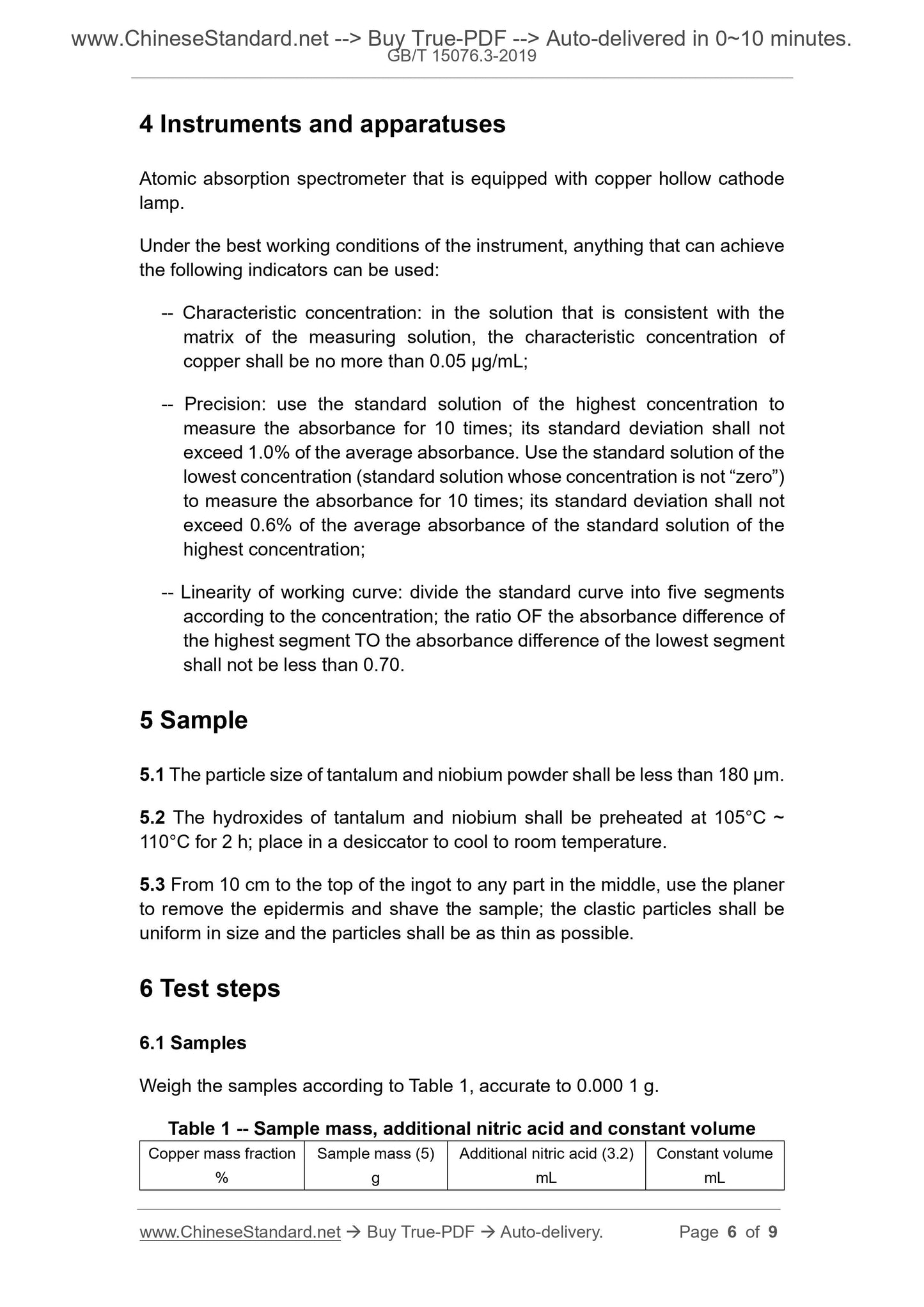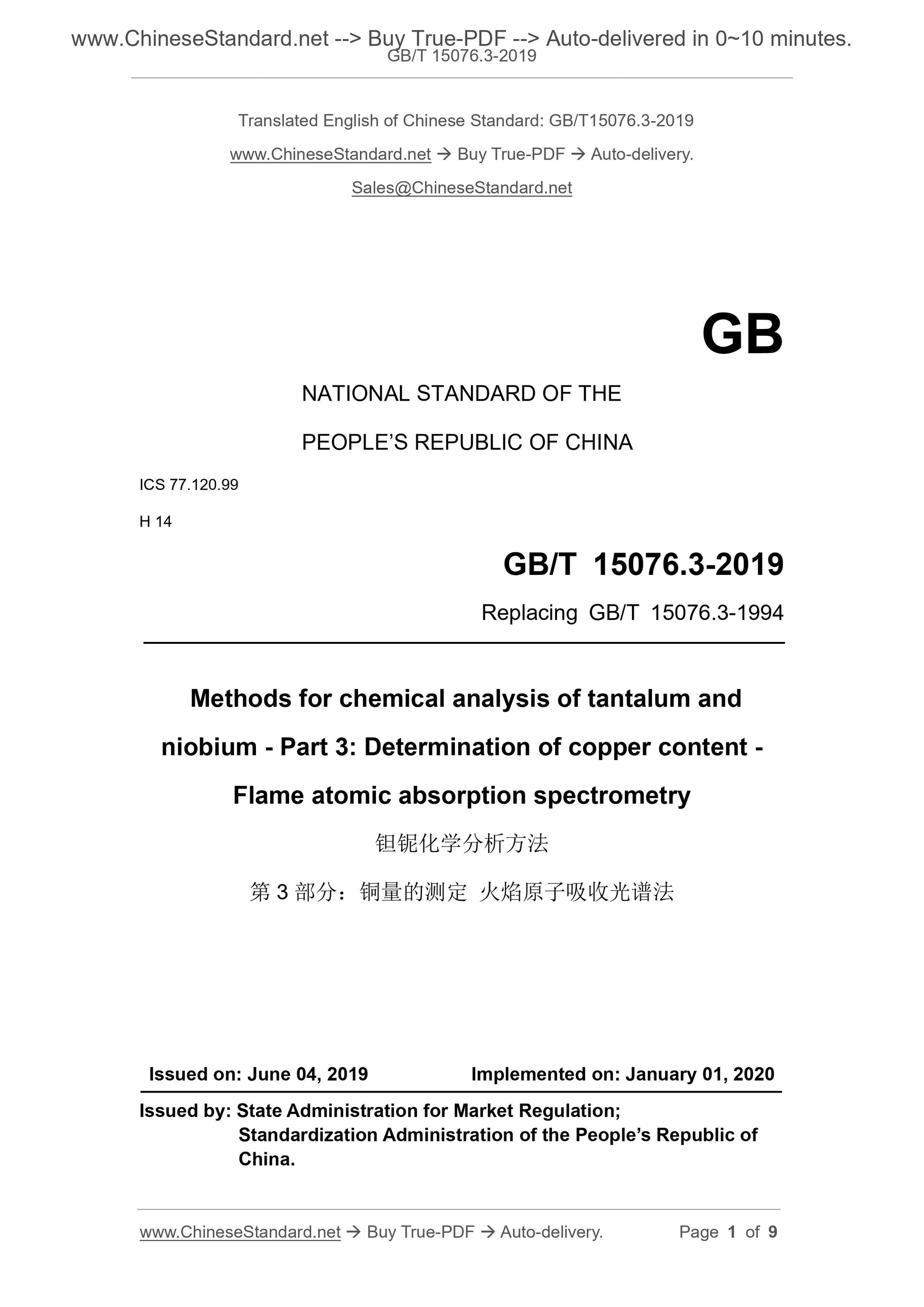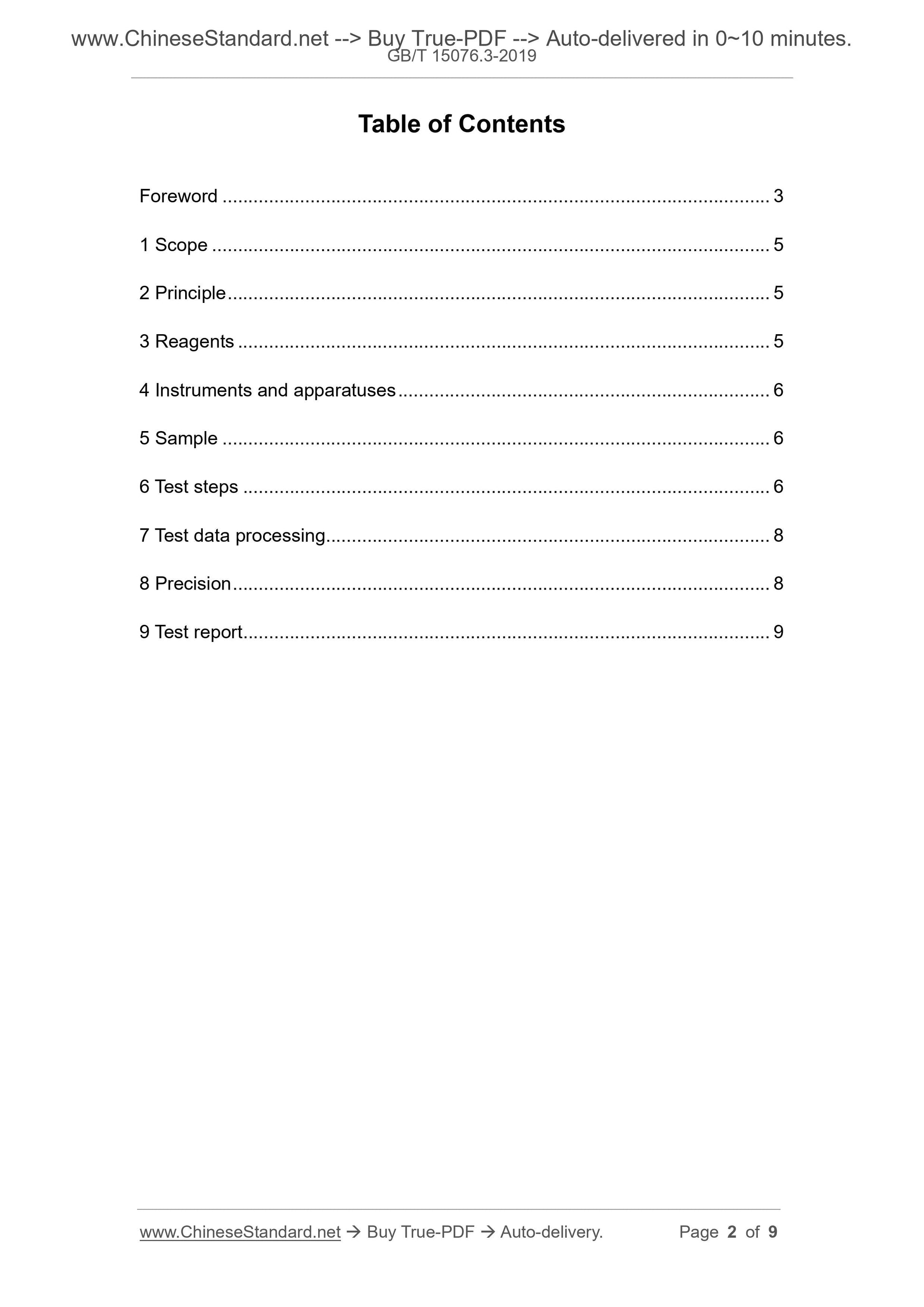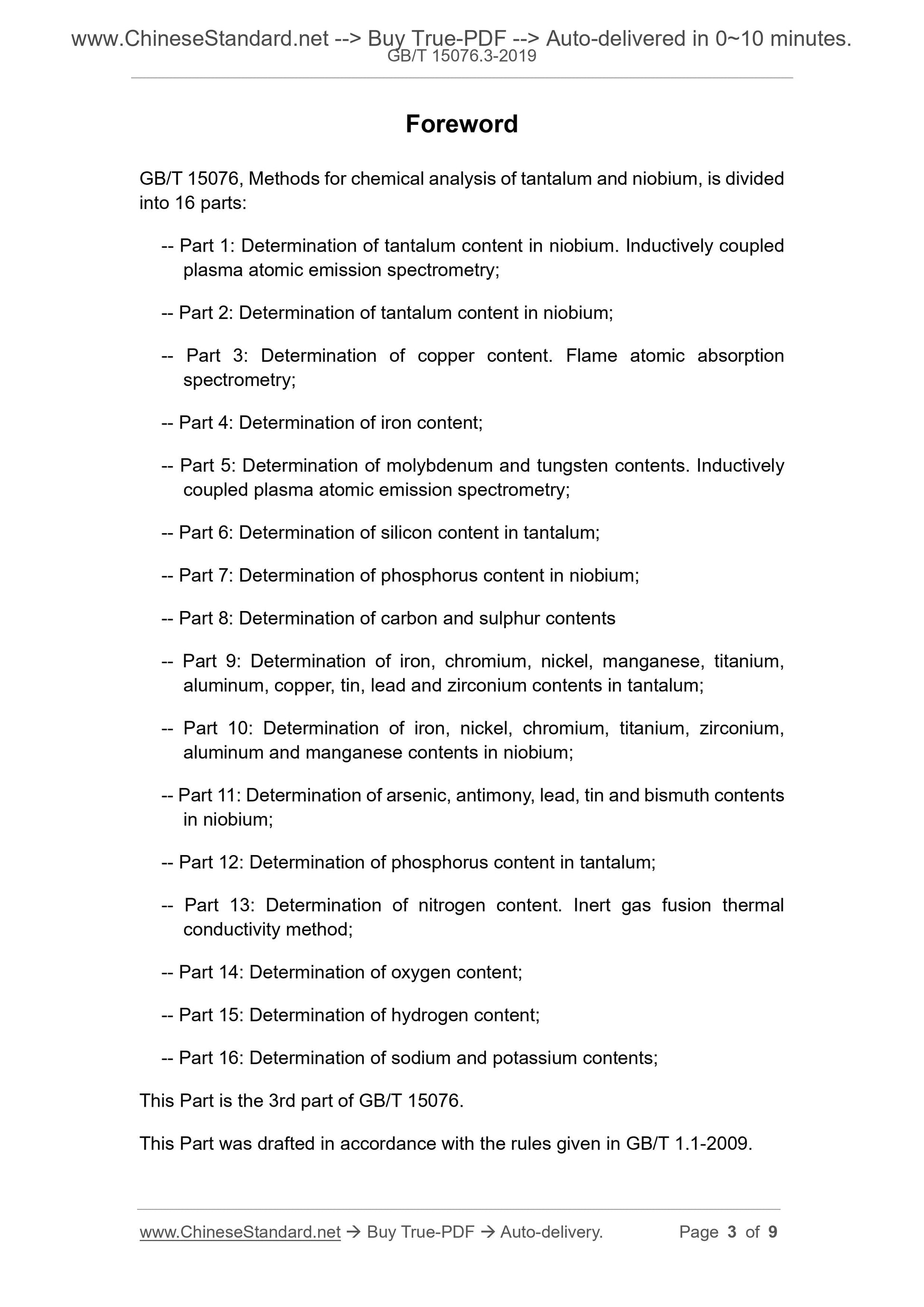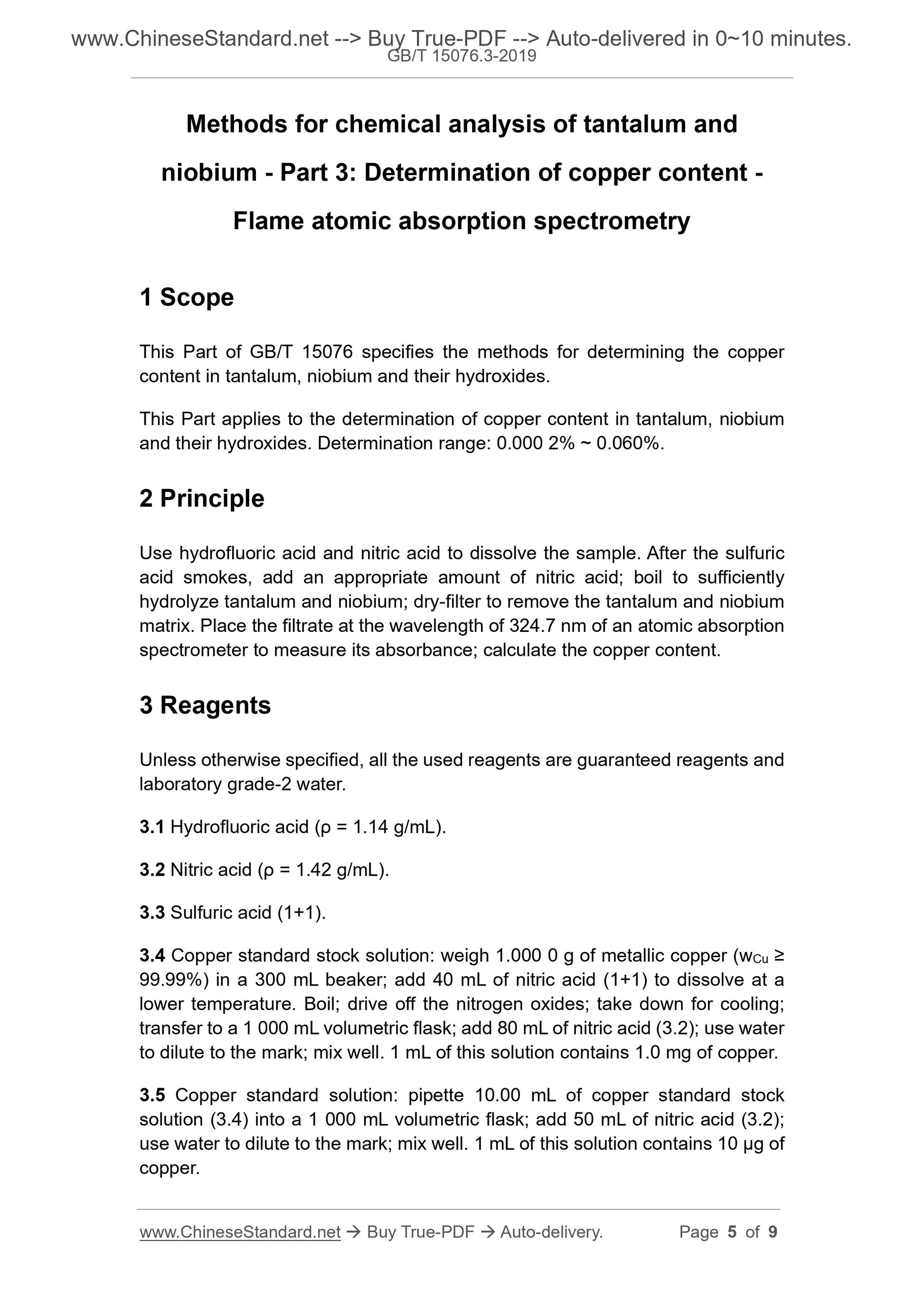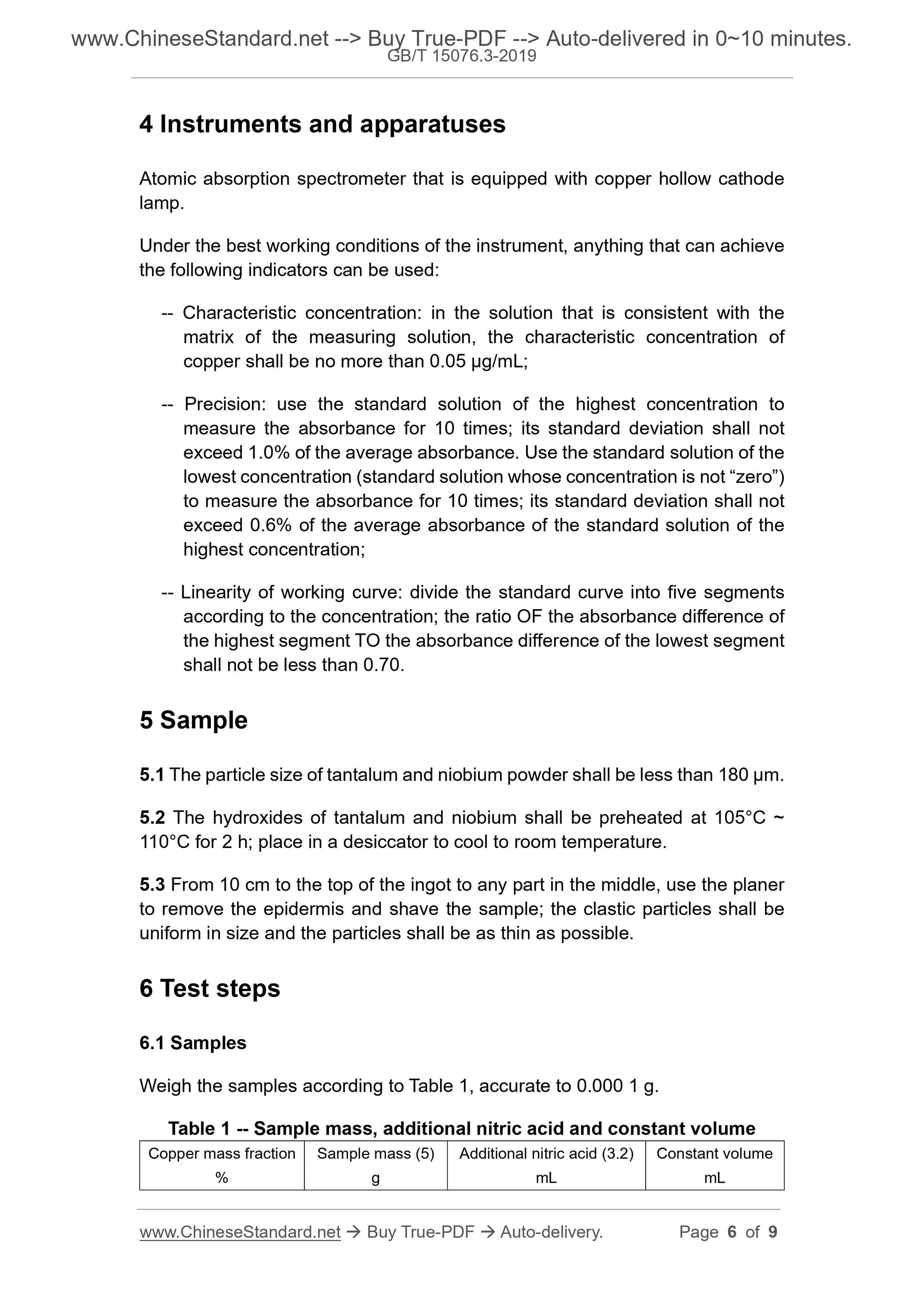1
/
of
5
www.ChineseStandard.us -- Field Test Asia Pte. Ltd.
GB/T 15076.3-2019 English PDF (GB/T15076.3-2019)
GB/T 15076.3-2019 English PDF (GB/T15076.3-2019)
Regular price
$90.00
Regular price
Sale price
$90.00
Unit price
/
per
Shipping calculated at checkout.
Couldn't load pickup availability
GB/T 15076.3-2019: Methods for chemical analysis of tantalum and niobium -- Part 3: Determination of copper content -- Flame atomic absorption spectrometry
Delivery: 9 seconds. Download (& Email) true-PDF + Invoice.
Get Quotation: Click GB/T 15076.3-2019 (Self-service in 1-minute)
Historical versions (Master-website): GB/T 15076.3-2019
Preview True-PDF (Reload/Scroll-down if blank)
GB/T 15076.3-2019
NATIONAL STANDARD OF THE
PEOPLE’S REPUBLIC OF CHINA
ICS 77.120.99
H 14
Replacing GB/T 15076.3-1994
Methods for chemical analysis of tantalum and
niobium - Part 3: Determination of copper content -
Flame atomic absorption spectrometry
ISSUED ON: JUNE 04, 2019
IMPLEMENTED ON: JANUARY 01, 2020
Issued by: State Administration for Market Regulation;
Standardization Administration of the People’s Republic of
China.
Table of Contents
Foreword ... 3
1 Scope ... 5
2 Principle ... 5
3 Reagents ... 5
4 Instruments and apparatuses ... 6
5 Sample ... 6
6 Test steps ... 6
7 Test data processing ... 8
8 Precision ... 8
9 Test report ... 9
Foreword
GB/T 15076, Methods for chemical analysis of tantalum and niobium, is divided
into 16 parts:
-- Part 1: Determination of tantalum content in niobium. Inductively coupled
plasma atomic emission spectrometry;
-- Part 2: Determination of tantalum content in niobium;
-- Part 3: Determination of copper content. Flame atomic absorption
spectrometry;
-- Part 4: Determination of iron content;
-- Part 5: Determination of molybdenum and tungsten contents. Inductively
coupled plasma atomic emission spectrometry;
-- Part 6: Determination of silicon content in tantalum;
-- Part 7: Determination of phosphorus content in niobium;
-- Part 8: Determination of carbon and sulphur contents
-- Part 9: Determination of iron, chromium, nickel, manganese, titanium,
aluminum, copper, tin, lead and zirconium contents in tantalum;
-- Part 10: Determination of iron, nickel, chromium, titanium, zirconium,
aluminum and manganese contents in niobium;
-- Part 11: Determination of arsenic, antimony, lead, tin and bismuth contents
in niobium;
-- Part 12: Determination of phosphorus content in tantalum;
-- Part 13: Determination of nitrogen content. Inert gas fusion thermal
conductivity method;
-- Part 14: Determination of oxygen content;
-- Part 15: Determination of hydrogen content;
-- Part 16: Determination of sodium and potassium contents;
This Part is the 3rd part of GB/T 15076.
This Part was drafted in accordance with the rules given in GB/T 1.1-2009.
Methods for chemical analysis of tantalum and
niobium - Part 3: Determination of copper content -
Flame atomic absorption spectrometry
1 Scope
This Part of GB/T 15076 specifies the methods for determining the copper
content in tantalum, niobium and their hydroxides.
This Part applies to the determination of copper content in tantalum, niobium
and their hydroxides. Determination range: 0.000 2% ~ 0.060%.
2 Principle
Use hydrofluoric acid and nitric acid to dissolve the sample. After the sulfuric
acid smokes, add an appropriate amount of nitric acid; boil to sufficiently
hydrolyze tantalum and niobium; dry-filter to remove the tantalum and niobium
matrix. Place the filtrate at the wavelength of 324.7 nm of an atomic absorption
spectrometer to measure its absorbance; calculate the copper content.
3 Reagents
Unless otherwise specified, all the used reagents are guaranteed reagents and
laboratory grade-2 water.
3.1 Hydrofluoric acid (ρ = 1.14 g/mL).
3.2 Nitric acid (ρ = 1.42 g/mL).
3.3 Sulfuric acid (1+1).
3.4 Copper standard stock solution: weigh 1.000 0 g of metallic copper (wCu ≥
99.99%) in a 300 mL beaker; add 40 mL of nitric acid (1+1) to dissolve at a
lower temperature. Boil; drive off the nitrogen oxides; take down for cooling;
transfer to a 1 000 mL volumetric flask; add 80 mL of nitric acid (3.2); use water
to dilute to the mark; mix well. 1 mL of this solution contains 1.0 mg of copper.
3.5 Copper standard solution: pipette 10.00 mL of copper standard stock
solution (3.4) into a 1 000 mL volumetric flask; add 50 mL of nitric acid (3.2);
use water to dilute to the mark; mix well. 1 mL of this solution contains 10 μg of
copper.
4 Instruments and apparatuses
Atomic absorption spectrometer that is equipped with copper hollow cathode
lamp.
Under the best working conditions of the instrument, anything that can achieve
the following indicators can be used:
-- Characteristic concentration: in the solution that is consistent with the
matrix of the measuring solution, the characteristic concentration of
copper shall be no more than 0.05 μg/mL;
-- Precision: use the standard solution of the highest concentration to
measure the absorbance for 10 times; its standard deviation shall not
exceed 1.0% of the average absorbance. Use the standard solution of the
lowest concentration (standard solution whose concentration is not “zero”)
to measure the absorbance for 10 times; its standard deviation shall not
exceed 0.6% of the average absorbance of the standard solution of the
highest concentration;
-- Linearity of working curve: divide the standard curve into five segments
according to the concentration; the ratio OF the absorbance difference of
the highest segment TO the absorbance difference of the lowest segment
shall not be less than 0.70.
5 Sample
5.1 The particle size of tantalum and niobium powder shall be less than 180 μm.
5.2 The hydroxides of tantalum and niobium shall be preheated at 105°C ~
110°C for 2 h; place in a desiccator to cool to room temperature.
5.3 From 10 cm to the top of the ingot to any part in the middle, use the planer
to remove the epidermis and shave the sample; the clastic particles shall be
uniform in size and the particles shall be as thin as possible.
6 Test steps
6.1 Samples
Weigh the samples according to Table 1, accurate to 0.000 1 g.
Table 1 -- Sample mass, additional nitric acid and constant volume
Copper mass fraction
Sample mass (5)
Additional nitric acid (3.2)
mL
Constant volume
mL
GB/T 15076.3-2019
NATIONAL STANDARD OF THE
PEOPLE’S REPUBLIC OF CHINA
ICS 77.120.99
H 14
Replacing GB/T 15076.3-1994
Methods for chemical analysis of tantalum and
niobium - Part 3: Determination of copper content -
Flame atomic absorption spectrometry
ISSUED ON: JUNE 04, 2019
IMPLEMENTED ON: JANUARY 01, 2020
Issued by: State Administration for Market Regulation;
Standardization Administration of the People’s Republic of
China.
Table of Contents
Foreword ... 3
1 Scope ... 5
2 Principle ... 5
3 Reagents ... 5
4 Instruments and apparatuses ... 6
5 Sample ... 6
6 Test steps ... 6
7 Test data processing ... 8
8 Precision ... 8
9 Test report ... 9
Foreword
GB/T 15076, Methods for chemical analysis of tantalum and niobium, is divided
into 16 parts:
-- Part 1: Determination of tantalum content in niobium. Inductively coupled
plasma atomic emission spectrometry;
-- Part 2: Determination of tantalum content in niobium;
-- Part 3: Determination of copper content. Flame atomic absorption
spectrometry;
-- Part 4: Determination of iron content;
-- Part 5: Determination of molybdenum and tungsten contents. Inductively
coupled plasma atomic emission spectrometry;
-- Part 6: Determination of silicon content in tantalum;
-- Part 7: Determination of phosphorus content in niobium;
-- Part 8: Determination of carbon and sulphur contents
-- Part 9: Determination of iron, chromium, nickel, manganese, titanium,
aluminum, copper, tin, lead and zirconium contents in tantalum;
-- Part 10: Determination of iron, nickel, chromium, titanium, zirconium,
aluminum and manganese contents in niobium;
-- Part 11: Determination of arsenic, antimony, lead, tin and bismuth contents
in niobium;
-- Part 12: Determination of phosphorus content in tantalum;
-- Part 13: Determination of nitrogen content. Inert gas fusion thermal
conductivity method;
-- Part 14: Determination of oxygen content;
-- Part 15: Determination of hydrogen content;
-- Part 16: Determination of sodium and potassium contents;
This Part is the 3rd part of GB/T 15076.
This Part was drafted in accordance with the rules given in GB/T 1.1-2009.
Methods for chemical analysis of tantalum and
niobium - Part 3: Determination of copper content -
Flame atomic absorption spectrometry
1 Scope
This Part of GB/T 15076 specifies the methods for determining the copper
content in tantalum, niobium and their hydroxides.
This Part applies to the determination of copper content in tantalum, niobium
and their hydroxides. Determination range: 0.000 2% ~ 0.060%.
2 Principle
Use hydrofluoric acid and nitric acid to dissolve the sample. After the sulfuric
acid smokes, add an appropriate amount of nitric acid; boil to sufficiently
hydrolyze tantalum and niobium; dry-filter to remove the tantalum and niobium
matrix. Place the filtrate at the wavelength of 324.7 nm of an atomic absorption
spectrometer to measure its absorbance; calculate the copper content.
3 Reagents
Unless otherwise specified, all the used reagents are guaranteed reagents and
laboratory grade-2 water.
3.1 Hydrofluoric acid (ρ = 1.14 g/mL).
3.2 Nitric acid (ρ = 1.42 g/mL).
3.3 Sulfuric acid (1+1).
3.4 Copper standard stock solution: weigh 1.000 0 g of metallic copper (wCu ≥
99.99%) in a 300 mL beaker; add 40 mL of nitric acid (1+1) to dissolve at a
lower temperature. Boil; drive off the nitrogen oxides; take down for cooling;
transfer to a 1 000 mL volumetric flask; add 80 mL of nitric acid (3.2); use water
to dilute to the mark; mix well. 1 mL of this solution contains 1.0 mg of copper.
3.5 Copper standard solution: pipette 10.00 mL of copper standard stock
solution (3.4) into a 1 000 mL volumetric flask; add 50 mL of nitric acid (3.2);
use water to dilute to the mark; mix well. 1 mL of this solution contains 10 μg of
copper.
4 Instruments and apparatuses
Atomic absorption spectrometer that is equipped with copper hollow cathode
lamp.
Under the best working conditions of the instrument, anything that can achieve
the following indicators can be used:
-- Characteristic concentration: in the solution that is consistent with the
matrix of the measuring solution, the characteristic concentration of
copper shall be no more than 0.05 μg/mL;
-- Precision: use the standard solution of the highest concentration to
measure the absorbance for 10 times; its standard deviation shall not
exceed 1.0% of the average absorbance. Use the standard solution of the
lowest concentration (standard solution whose concentration is not “zero”)
to measure the absorbance for 10 times; its standard deviation shall not
exceed 0.6% of the average absorbance of the standard solution of the
highest concentration;
-- Linearity of working curve: divide the standard curve into five segments
according to the concentration; the ratio OF the absorbance difference of
the highest segment TO the absorbance difference of the lowest segment
shall not be less than 0.70.
5 Sample
5.1 The particle size of tantalum and niobium powder shall be less than 180 μm.
5.2 The hydroxides of tantalum and niobium shall be preheated at 105°C ~
110°C for 2 h; place in a desiccator to cool to room temperature.
5.3 From 10 cm to the top of the ingot to any part in the middle, use the planer
to remove the epidermis and shave the sample; the clastic particles shall be
uniform in size and the particles shall be as thin as possible.
6 Test steps
6.1 Samples
Weigh the samples according to Table 1, accurate to 0.000 1 g.
Table 1 -- Sample mass, additional nitric acid and constant volume
Copper mass fraction
Sample mass (5)
Additional nitric acid (3.2)
mL
Constant volume
mL
Delivery: 9 seconds. Download (& Email) true-PDF + Invoice.
Get Quotation: Click GB/T 15076.3-2019 (Self-service in 1-minute)
Historical versions (Master-website): GB/T 15076.3-2019
Preview True-PDF (Reload/Scroll-down if blank)
GB/T 15076.3-2019
NATIONAL STANDARD OF THE
PEOPLE’S REPUBLIC OF CHINA
ICS 77.120.99
H 14
Replacing GB/T 15076.3-1994
Methods for chemical analysis of tantalum and
niobium - Part 3: Determination of copper content -
Flame atomic absorption spectrometry
ISSUED ON: JUNE 04, 2019
IMPLEMENTED ON: JANUARY 01, 2020
Issued by: State Administration for Market Regulation;
Standardization Administration of the People’s Republic of
China.
Table of Contents
Foreword ... 3
1 Scope ... 5
2 Principle ... 5
3 Reagents ... 5
4 Instruments and apparatuses ... 6
5 Sample ... 6
6 Test steps ... 6
7 Test data processing ... 8
8 Precision ... 8
9 Test report ... 9
Foreword
GB/T 15076, Methods for chemical analysis of tantalum and niobium, is divided
into 16 parts:
-- Part 1: Determination of tantalum content in niobium. Inductively coupled
plasma atomic emission spectrometry;
-- Part 2: Determination of tantalum content in niobium;
-- Part 3: Determination of copper content. Flame atomic absorption
spectrometry;
-- Part 4: Determination of iron content;
-- Part 5: Determination of molybdenum and tungsten contents. Inductively
coupled plasma atomic emission spectrometry;
-- Part 6: Determination of silicon content in tantalum;
-- Part 7: Determination of phosphorus content in niobium;
-- Part 8: Determination of carbon and sulphur contents
-- Part 9: Determination of iron, chromium, nickel, manganese, titanium,
aluminum, copper, tin, lead and zirconium contents in tantalum;
-- Part 10: Determination of iron, nickel, chromium, titanium, zirconium,
aluminum and manganese contents in niobium;
-- Part 11: Determination of arsenic, antimony, lead, tin and bismuth contents
in niobium;
-- Part 12: Determination of phosphorus content in tantalum;
-- Part 13: Determination of nitrogen content. Inert gas fusion thermal
conductivity method;
-- Part 14: Determination of oxygen content;
-- Part 15: Determination of hydrogen content;
-- Part 16: Determination of sodium and potassium contents;
This Part is the 3rd part of GB/T 15076.
This Part was drafted in accordance with the rules given in GB/T 1.1-2009.
Methods for chemical analysis of tantalum and
niobium - Part 3: Determination of copper content -
Flame atomic absorption spectrometry
1 Scope
This Part of GB/T 15076 specifies the methods for determining the copper
content in tantalum, niobium and their hydroxides.
This Part applies to the determination of copper content in tantalum, niobium
and their hydroxides. Determination range: 0.000 2% ~ 0.060%.
2 Principle
Use hydrofluoric acid and nitric acid to dissolve the sample. After the sulfuric
acid smokes, add an appropriate amount of nitric acid; boil to sufficiently
hydrolyze tantalum and niobium; dry-filter to remove the tantalum and niobium
matrix. Place the filtrate at the wavelength of 324.7 nm of an atomic absorption
spectrometer to measure its absorbance; calculate the copper content.
3 Reagents
Unless otherwise specified, all the used reagents are guaranteed reagents and
laboratory grade-2 water.
3.1 Hydrofluoric acid (ρ = 1.14 g/mL).
3.2 Nitric acid (ρ = 1.42 g/mL).
3.3 Sulfuric acid (1+1).
3.4 Copper standard stock solution: weigh 1.000 0 g of metallic copper (wCu ≥
99.99%) in a 300 mL beaker; add 40 mL of nitric acid (1+1) to dissolve at a
lower temperature. Boil; drive off the nitrogen oxides; take down for cooling;
transfer to a 1 000 mL volumetric flask; add 80 mL of nitric acid (3.2); use water
to dilute to the mark; mix well. 1 mL of this solution contains 1.0 mg of copper.
3.5 Copper standard solution: pipette 10.00 mL of copper standard stock
solution (3.4) into a 1 000 mL volumetric flask; add 50 mL of nitric acid (3.2);
use water to dilute to the mark; mix well. 1 mL of this solution contains 10 μg of
copper.
4 Instruments and apparatuses
Atomic absorption spectrometer that is equipped with copper hollow cathode
lamp.
Under the best working conditions of the instrument, anything that can achieve
the following indicators can be used:
-- Characteristic concentration: in the solution that is consistent with the
matrix of the measuring solution, the characteristic concentration of
copper shall be no more than 0.05 μg/mL;
-- Precision: use the standard solution of the highest concentration to
measure the absorbance for 10 times; its standard deviation shall not
exceed 1.0% of the average absorbance. Use the standard solution of the
lowest concentration (standard solution whose concentration is not “zero”)
to measure the absorbance for 10 times; its standard deviation shall not
exceed 0.6% of the average absorbance of the standard solution of the
highest concentration;
-- Linearity of working curve: divide the standard curve into five segments
according to the concentration; the ratio OF the absorbance difference of
the highest segment TO the absorbance difference of the lowest segment
shall not be less than 0.70.
5 Sample
5.1 The particle size of tantalum and niobium powder shall be less than 180 μm.
5.2 The hydroxides of tantalum and niobium shall be preheated at 105°C ~
110°C for 2 h; place in a desiccator to cool to room temperature.
5.3 From 10 cm to the top of the ingot to any part in the middle, use the planer
to remove the epidermis and shave the sample; the clastic particles shall be
uniform in size and the particles shall be as thin as possible.
6 Test steps
6.1 Samples
Weigh the samples according to Table 1, accurate to 0.000 1 g.
Table 1 -- Sample mass, additional nitric acid and constant volume
Copper mass fraction
Sample mass (5)
Additional nitric acid (3.2)
mL
Constant volume
mL
GB/T 15076.3-2019
NATIONAL STANDARD OF THE
PEOPLE’S REPUBLIC OF CHINA
ICS 77.120.99
H 14
Replacing GB/T 15076.3-1994
Methods for chemical analysis of tantalum and
niobium - Part 3: Determination of copper content -
Flame atomic absorption spectrometry
ISSUED ON: JUNE 04, 2019
IMPLEMENTED ON: JANUARY 01, 2020
Issued by: State Administration for Market Regulation;
Standardization Administration of the People’s Republic of
China.
Table of Contents
Foreword ... 3
1 Scope ... 5
2 Principle ... 5
3 Reagents ... 5
4 Instruments and apparatuses ... 6
5 Sample ... 6
6 Test steps ... 6
7 Test data processing ... 8
8 Precision ... 8
9 Test report ... 9
Foreword
GB/T 15076, Methods for chemical analysis of tantalum and niobium, is divided
into 16 parts:
-- Part 1: Determination of tantalum content in niobium. Inductively coupled
plasma atomic emission spectrometry;
-- Part 2: Determination of tantalum content in niobium;
-- Part 3: Determination of copper content. Flame atomic absorption
spectrometry;
-- Part 4: Determination of iron content;
-- Part 5: Determination of molybdenum and tungsten contents. Inductively
coupled plasma atomic emission spectrometry;
-- Part 6: Determination of silicon content in tantalum;
-- Part 7: Determination of phosphorus content in niobium;
-- Part 8: Determination of carbon and sulphur contents
-- Part 9: Determination of iron, chromium, nickel, manganese, titanium,
aluminum, copper, tin, lead and zirconium contents in tantalum;
-- Part 10: Determination of iron, nickel, chromium, titanium, zirconium,
aluminum and manganese contents in niobium;
-- Part 11: Determination of arsenic, antimony, lead, tin and bismuth contents
in niobium;
-- Part 12: Determination of phosphorus content in tantalum;
-- Part 13: Determination of nitrogen content. Inert gas fusion thermal
conductivity method;
-- Part 14: Determination of oxygen content;
-- Part 15: Determination of hydrogen content;
-- Part 16: Determination of sodium and potassium contents;
This Part is the 3rd part of GB/T 15076.
This Part was drafted in accordance with the rules given in GB/T 1.1-2009.
Methods for chemical analysis of tantalum and
niobium - Part 3: Determination of copper content -
Flame atomic absorption spectrometry
1 Scope
This Part of GB/T 15076 specifies the methods for determining the copper
content in tantalum, niobium and their hydroxides.
This Part applies to the determination of copper content in tantalum, niobium
and their hydroxides. Determination range: 0.000 2% ~ 0.060%.
2 Principle
Use hydrofluoric acid and nitric acid to dissolve the sample. After the sulfuric
acid smokes, add an appropriate amount of nitric acid; boil to sufficiently
hydrolyze tantalum and niobium; dry-filter to remove the tantalum and niobium
matrix. Place the filtrate at the wavelength of 324.7 nm of an atomic absorption
spectrometer to measure its absorbance; calculate the copper content.
3 Reagents
Unless otherwise specified, all the used reagents are guaranteed reagents and
laboratory grade-2 water.
3.1 Hydrofluoric acid (ρ = 1.14 g/mL).
3.2 Nitric acid (ρ = 1.42 g/mL).
3.3 Sulfuric acid (1+1).
3.4 Copper standard stock solution: weigh 1.000 0 g of metallic copper (wCu ≥
99.99%) in a 300 mL beaker; add 40 mL of nitric acid (1+1) to dissolve at a
lower temperature. Boil; drive off the nitrogen oxides; take down for cooling;
transfer to a 1 000 mL volumetric flask; add 80 mL of nitric acid (3.2); use water
to dilute to the mark; mix well. 1 mL of this solution contains 1.0 mg of copper.
3.5 Copper standard solution: pipette 10.00 mL of copper standard stock
solution (3.4) into a 1 000 mL volumetric flask; add 50 mL of nitric acid (3.2);
use water to dilute to the mark; mix well. 1 mL of this solution contains 10 μg of
copper.
4 Instruments and apparatuses
Atomic absorption spectrometer that is equipped with copper hollow cathode
lamp.
Under the best working conditions of the instrument, anything that can achieve
the following indicators can be used:
-- Characteristic concentration: in the solution that is consistent with the
matrix of the measuring solution, the characteristic concentration of
copper shall be no more than 0.05 μg/mL;
-- Precision: use the standard solution of the highest concentration to
measure the absorbance for 10 times; its standard deviation shall not
exceed 1.0% of the average absorbance. Use the standard solution of the
lowest concentration (standard solution whose concentration is not “zero”)
to measure the absorbance for 10 times; its standard deviation shall not
exceed 0.6% of the average absorbance of the standard solution of the
highest concentration;
-- Linearity of working curve: divide the standard curve into five segments
according to the concentration; the ratio OF the absorbance difference of
the highest segment TO the absorbance difference of the lowest segment
shall not be less than 0.70.
5 Sample
5.1 The particle size of tantalum and niobium powder shall be less than 180 μm.
5.2 The hydroxides of tantalum and niobium shall be preheated at 105°C ~
110°C for 2 h; place in a desiccator to cool to room temperature.
5.3 From 10 cm to the top of the ingot to any part in the middle, use the planer
to remove the epidermis and shave the sample; the clastic particles shall be
uniform in size and the particles shall be as thin as possible.
6 Test steps
6.1 Samples
Weigh the samples according to Table 1, accurate to 0.000 1 g.
Table 1 -- Sample mass, additional nitric acid and constant volume
Copper mass fraction
Sample mass (5)
Additional nitric acid (3.2)
mL
Constant volume
mL
Share
